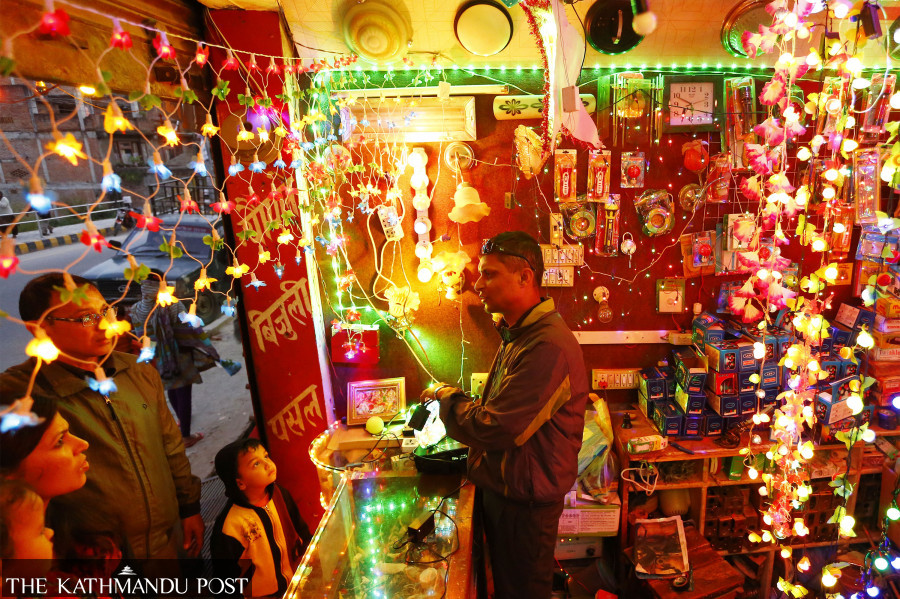Money
Traders doubtful about Tihar sales after dour Dashain
The government’s constrictive trade policy has dampened the market mood, industry insiders say.
Krishana Prasain
The Dashain shopping season ended on a subdued note with banks low on cash and the government continuing to strangle imports, resulting in fewer choices for holiday shoppers.
The embargo on mobiles, automobiles, heavy motorcycles and liquor kept festival sales on the slow side, and traders aren't much hopeful about Tihar business either.
Tihar, the festival of lights and flowers, is just a week away, but the government’s constrictive trade policy has dampened the market mood, industry insiders say.
Increasing price pressure remains the most immediate threat to the market as it has squeezed people's real incomes.
According to an International Monetary Fund report, China’s frequent lockdowns under its zero Covid policy have taken a toll on the economy, especially in the second quarter of 2022.
Given the size of China’s economy and its importance for global supply chains, this will weigh heavily on global trade and activity.
The external environment is already very challenging for many emerging markets and developing economies. The sharp appreciation of the United States dollar adds significantly to domestic price pressures and to the cost-of-living crisis for these countries, according to the report.
“The import of festival lights has plunged by 50 percent as compared to past years,” said Sudarshan Prasad Paudyal, president of the Federation of Electrical Entrepreneurs of Nepal. “This is mainly due to the closure of the northern border.”
Although China allowed standard container trucks to pass into Nepal on the eve of Dashain, traders did not place new import orders, particularly for the Tihar shopping season.
The market, however, will see one change. People will light traditional oil lamps made of clay instead of eclectic lamps which are mostly imported from China, according to traders.
“There is also the mandatory provision of the government to keep 100 percent margin while opening a letter of credit to import goods,” said Paudyal.
"People are not in a celebratory mood like in previous years as their disposable income has been squeezed by rising prices," he said.
People decorate their homes with strings of light bulbs hoping that Laxmi, the goddess of wealth, will visit them and bless them with prosperity. Christmas lights, rope lights and disco lights, among other products, make up most of the imports for the festival.
Last year, festival lights worth Rs400 million arrived for Tihar, according to the federation.
The price of festival lights may rise by 20 percent this festival season, as per Paudyal.
Though there are different festival lights available in the market, a basic and simple festival light that used to cost around Rs200 will cost around Rs250 this year.
Nepal imports 90 percent of its festival lights from China.
With sufficient domestic production and Tihar occurring at the right time, the price of marigolds, however, will not increase this year, traders said.
According to the Floriculture Association Nepal, demand for the de rigueur gold flowers is expected to increase to 2 million garlands this Tihar.
The wholesale price of marigolds may remain unchanged this year at Rs55 per garland. A 1-metre garland contains 40 flowers.
"Of the total requirement of 2 million garlands, 1.7 million garlands will be fulfilled through domestic production and the rest will be imported from India, the federation said.
Vibrant yellow marigolds and milky white chrysanthemums are necessary offerings to Laxmi during Tihar.
The federation expects 425,000 globe amaranth garlands (makhmali) will be needed for the Bhai Tika ceremony this year, and domestic production will fulfil the requirement.
The wholesale price of globe amaranth will likely rise by Rs5 per garland to Rs40 this year.
The association believes sales of marigolds, globe amaranths and chrysanthemums will reach Rs130.50 million this Tihar. Last year's sales were worth Rs110.92 million.
The marigolds and globe amaranths sold in the valley comes from around 30 districts across the country.
Prices of dried fruits will remain on the high side due to the stronger US dollar and global inflation that has made almost all goods more expensive.
The Nepali rupee has been in free fall against the dollar and crossed the 132 mark.
Packets of nutritious nuts, seeds and other items are given as gifts by sisters to their brothers during the ceremonies, and sales soar this time of the year, driving up prices.
Amul Kaji Tuladhar, general secretary of the Nepal Retailers Association, said prices of dries fruits had increased by 3-4 percent compared to last year’s festive season.
"Tihar accounts for 30 to 40 percent of annual sales of dried fruits," Tuladhar said.
According to Tuladhar, the price of pistachio has increased from Rs2,100 per kg last year to Rs2,200. The price of dates has risen from Rs350 per kg to Rs400 while cashew nut remains unchanged at Rs1,500 per kg.
The price of almond too remains unchanged at Rs1,100 to Rs1,300 per kg.
The price of raisin has gone up from Rs500 per kg to Rs600, and walnut remains steady at Rs500 to Rs600 per kg.
The price of green cardamom, however, has fallen sharply to Rs3,200 per kg from Rs5,990 last year.
Nepalis like to spend lavishly during festivals, often saving up the entire year.
Consumer spending accounts for 90 percent of Nepal’s gross domestic product of Rs4.8 trillion, according to Nepal Rastra Bank. This translates into a monthly consumption of Rs400 billion which swells during the September-October festival season.




 13.12°C Kathmandu
13.12°C Kathmandu














